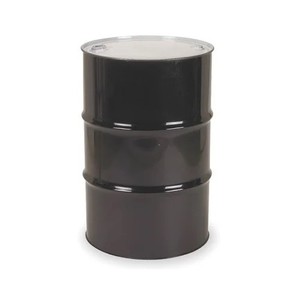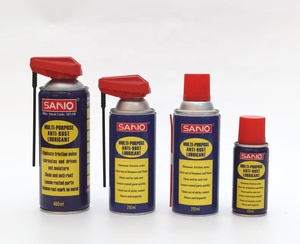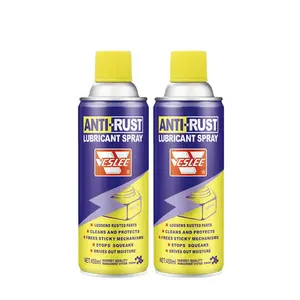(118117 products available)























































































































































































Lubricants are classified into several types based on their consistency and components. They range from basic oils and greases to high-tech. These include:
Water-based lubricants
These are the most commonly used types of lubricantes in the market today. This is because they are soluble in water, hence easy to wash off. They are popular for use in hospitals as they are body friendly. Also, they are compatible with latex condoms and often used as a base for most lotions. However, they are not too slippery and may require reapplication.
Silicone-based lubricants
These lubricants are more durable than water-based ones as they do not wash off easily. Silicone lubes provide a smooth, long-lasting slip with a silky, non-greasy feel. Usually, only a small amount is needed to ensure its effectiveness. Often used for massage and compatible with most condoms except latex. Their inability to mix with water makes them ideal for use in swimming pools or showers. However, their difficulty in removability can be a disadvantage in certain situations. Also, silicone-based lubes are normally costly compared to water-based ones.
Oil-based lubricants
These lubricants are made of oils like mineral oil, coconut oil, or petroleum jelly. They provide a thick and long-lasting barrier for better lubrication. They are especially recommended for use in showers. Oil-based lubricants are very effective with long-lasting moisture and are ideal for sensitive skin. They are often used in hospitals to patients who require a lubricant that will last longer without irritation. Nevertheless, they are not compatible with latex condoms, and they may stain fabrics.
Organic lubricants
Organic lubricants are made from natural plant extracts and are often chosen for their soothing properties and eco-friendly composition. They include olive oil, aloe vera, and almond oil. This lubricant is ideal for users who want to avoid chemicals. They are also suitable for sensitive skin and are sometimes used in organic products. However, they may not be as durable as silicone-based lubes, and some users may find them less slippery than oil-based lubes.
Hybrid lubricants
These lubricants are a blend of water-based and silicone-based lubes. They aim to combine the best features of both: the easy washability of water and the long-lasting slip of silicone. Usually, they are smoother than water-based lubes and more affordable than silicone-based ones. Hybrid lubricants are commonly used in both massage and sexual activities. They are also compatible with most condoms and can enhance the ease of use for devices. Despite these, they can be more expensive than pure water-based lubes and may require more thorough cleaning to avoid residue.
Medical applications
Lubricants play a critical role in healthcare settings, especially for patients with sensitivity in private parts, as they greatly enhance comfort. They reduce friction between medical devices and the body during procedures. This aids in protecting tissues from damage or irritation. Lubricants are used in implants and prosthetics to reduce wear and tear while increasing comfort and functionality. They also maintain the softness and longevity of the materials used in the devices. Lubricants are employed to enhance the glide of catheters and other medical instruments. This allows for smoother insertions with minimal discomfort for the patient. They are used during sexual health examinations or treatments and help in reducing discomfort and pain. This makes them an essential part of patient care.
Personal care and cosmetics
Lubricants are often used in the personal care industry for skin hydration and protection against dryness. They are a critical part of moisturizers which aid in preventing skin chapping by forming a protective barrier. This helps in sealing moisture within the skin. In cosmetics, lubricants like lubricante para labios provide an even application of makeup and help to keep lips moisturized. This prevents them from drying or cracking. Lubricants are also used in hair products to reduce friction between strands. This makes it easier to comb or style the hair without damage. They are used in anti-chafing creams which help protect the skin in areas prone to rubbing. This is mostly in individuals who engage in athletic activities or long-distance walkers.
Industrial applications
Joints are always the most vulnerable part of machines. This is because they are affected the most by friction. Lubricants are used in machinery to reduce friction between moving parts. This helps in minimizing wear and tear on mechanical components. It helps in protecting fans, pumps, or generators. Lubricants are used on industrial equipment to lower maintenance cost. This is because they help to extend the lifespan of machinery. As it reduces friction, lubrication also helps machinery to run smoother and more effectively. This helps to enhance efficiency by reducing energy consumption. Equipment breakdown can be very expensive. Lubricants help prevent the rusting of equipment. Hence, they protect metal parts from corroding when exposed to moisture and oxygen. This helps in keeping equipment reliable and extending their lifespan.
Improved comfort and safety in sexual activity
Adequate lubrication during sexual activity helps to increase comfort by reducing friction. This helps to eliminate irritation and associated discomfort. Lubricants can enhance sensation. This makes the experience more pleasurable for both partners. They help to reduce the stimulation caused by friction. Lubricants are critical during an intimate encounter since they help to increase safety by reducing the risk of micro-tears or injury in genital areas. This is especially important for individuals with dry skin or irritation. Some lubricants can also ease the use of latex condoms. This helps to minimize the risk of breakage while increasing comfort.
Improved Performance and Longevity of products
Lubricants can enhance the effectiveness of various products during intimacy by providing a smoother, more pleasurable experience. This makes sexual activity more enjoyable and helps to increase stimulation. Lubricants can also aid in extending the lifespan of intimate products like toys by reducing friction. This helps to minimize wear and tear on the materials used in the products. Lubricant can enhance post-natal intimacy for couples who use lubes. This makes it easier for couples to engage in intimacy after childbirth without discomfort. Certain lubricants also have soothing qualities. This helps to reduce irritation and promotes healing.
Water
Water is the main ingredient in most types of lubricants, especially in water-based lubes. Its primary role is to provide a smooth, slippery texture that reduces friction and makes the product easy to spread and use. It also serves to hydrate the skin temporarily, leaving a fresh, moisturized feel.
Glycerin
Glycerin is a common ingredient in many lubricants. It helps to retain moisture and keep the skin hydrated. It is a natural compound that is thick and helps to increase the slipperiness of the lubricant, making it more effective during use. It is often derived from vegetable oils, although it can also be sourced from animal fats.
Silicone
Silicone is used in silicone-based lubricants, which are known for their long-lasting slipperiness. It does not absorb into the skin but instead forms a protective barrier on the surface. This makes it exceptionally smooth and slippery, enhancing comfort and reducing friction during activities like massage or sexual intercourse. Common types of silicone used include dimethicone and cyclopentasiloxane.
Natural oils
These are included in organic and oil-based lubricants. They are usually produced from plants and include almond oil, coconut oil, and olive oil. Almond oil contains fatty acids and vitamins that nourish the skin, leaving it soft and moisturized. Coconut oil has antifungal properties and works to reduce irritation while providing a smooth glide. Olive oil is rich in antioxidants and helps to repair and protect skin cells, which in turn aids in preventing dryness and prolongs the lubricant’s shelf life.
Cellulose derivatives
Cellulose derivatives like hydroxyethylcellulose and carboxymethylcellulose are commonly found in lubes. They serve as thickening agents and help to create a smooth, gel-like consistency. This aids in the lubricant's longevity and effectiveness, preventing it from breaking down too quickly during use. They are also effective for various skin types, including sensitive skin, as they are usually gentle and non-irritating.
Understand the lubricant types
Lubricants are normally categorized into three general types. They are water-based, silicone-based, and oil-based. Each category has distinct characteristics. Water-based lubes are easy to wash off and latex condom compatible. Silicone-based lubes have a longer-lasting slip and are usually resistant to water. Oil-based lubes are durable but incompatible with latex condoms. Knowing the lubricant types will make buyers know the various customers it will serve.
Consider customers’ needs
Buyers should get lubricants that will meet their customers’ needs. They should stock lubes that cater to people with sensitive skin or latex allergies. Customers with sensitive skin should ideally use water or organic-based lubes. They are more suited for them since they don’t have harsh chemicals. Also, lubricants that offer special benefits like prolonging intimacy or increasing fertility are ideal to have. This is because they cater to specific audiences that will help in meeting their customers’ needs.
Store various lubes
Buyers should store both flavored and regular lubes. They help to enhance intimacy experiences by giving taste during use. This makes them ideal for couples looking to spice things up. They are normally formulated with natural or artificial flavors. Buyers should also stock personal lubricants with natural ingredients for health-conscious customers. These are usually derived from plants. Buyers should also ensure a variety of lubricant bases, such as water, silicone, and oil. These cater to different preferences and needs. They help customers easily find the lube that meets their requirements.
Check the ingredients list
Getting lubricants that have high-quality ingredients will not only benefit customers but also boost the seller's reputation. Buy lubricants with natural and organic ingredients. They are often preferred by customers concerned about their health or who have sensitive skin. Customers who have special preferences will also love lubes with vegan or gluten-free labels. Customers who are concerned about health will avoid those that have artificial additives and fragrances. Since customers are likely to have different preferences and needs regarding lubrication, they should look for lubes with diverse ingredients.
Check the compatibility of lubricants
Buyers should ensure the lubricants they get are compatible with condoms. This is because a large number of customers will use condoms. Water-based lubricants work well with latex. Silicone-based lubes are suited for latex condoms and non-latex like lambskin. Unfortunately, oil-based lubes are normally incompatible with latex condoms. They expose users to the risk of condom failure. Buyers can also get lubes with added special benefits that enhance compatibility.
Get products from well-known manufacturers
To ensure quality, buyers should get lubricants from reputable brands. Look for lubricants that have identifiable certifications and those that have been tested by physicians. Research previously published testimonials by customers and experts to get feedback on the product's quality. Often, lubes from trusted brands usually have superior quality. Although there are always exceptions, it is generally agreed that items manufactured by reputable businesses are of a higher quality.
A1: Lubricants are substances applied to minimize friction between two surfaces that are in contact with one another. Its main purpose is to create a film or layer between the surfaces. This enables them to glide past each other more easily. This reduces wear and tear, heat generation, and the likelihood of damage. They are classified based on their composition, use, and the type of application. They include oil-based, water-based, silicone-based, and greases. They are commonly used in various settings. This includes machinery maintenance, medical procedures, sexual health, and personal care. Lubricants can improve performance, enhance comfort, and extend the life of equipment and devices.
A2: Lubrication is the process of applying a lubricant to reduce friction between surfaces. Its main goal is to create a protective film that separates these surfaces. This film minimizes direct contact, thereby reducing wear and tear, heat generation, and risk of damage. On the other hand, 'lube' is simply a shorthand term for lubricant, which is any substance used in the process of lubrication. A lubricant is categorized based on its composition, functionality, and application method. The types are oil-based, water-based, silicone-based, and greases.
A3: Lubes are critical in enhancing the efficiency of machinery by reducing friction between moving parts. This helps in minimizing wear and extends the life of equipment, saving money and increasing reliability. They reduce friction and mechanical resistance. Hence, they enable machines to operate more smoothly with less energy consumption. This lowers operating costs. Since they reduce heat generation, lubricants enable machines to run cooler. This decreases the risk of overheating and associated damages. Lubes also acts as a protective barrier against corrosion. This protects metal components from rusting when exposed to moisture and contaminants. They also facilitate better equipment hygiene by preventing the accumulation of debris and contaminants.
Using the wrong type of lubricant
Using the wrong lubricant type can lead to irritation or discomfort. Others may think that all lubes are compatible with condoms. That is a mistake since oil-based lubes are incompatible with latex condoms.
Inadequate lubrication
Inadequate lubrication can cause friction. This leads to discomfort or irritation. It also affects the performance of machines and products. Some people may also overshoot and apply too much lubrication.
Improper storage
Poor storage conditions can decrease the lubricant's lifespan and effectiveness. Excessive heat or exposure to light can break down the product's ingredients. This renders it less effective.
Neglecting pre-use testing
Going straight for the lube without testing a small patch can be irritating. It is always advisable to first apply a small amount. Allow a few minutes to see how the skin will react before going all out.
A5: Lubes are made of various ingredients. Some of them are oily, cellulose, and silicone-based substances. Oils are derived from petroleum, naturally occurring mineral, plant, and synthetically produced. Petroleum jelly has been a staple ingredient in grease-based lubricants for ages. People love it because of its long-lasting and easily accessible nature. Silicone-based lubricants are usually manufactured from chemical elements. Cellulose-based derivatives are commonly used as thickening agents. This gives lubricants a smooth and cohesive texture. Grease-like lubricants are also mixed with humectants like glycerin and natural extracts. This helps to provide a moisturizing effect while extending the lubricant's longevity.